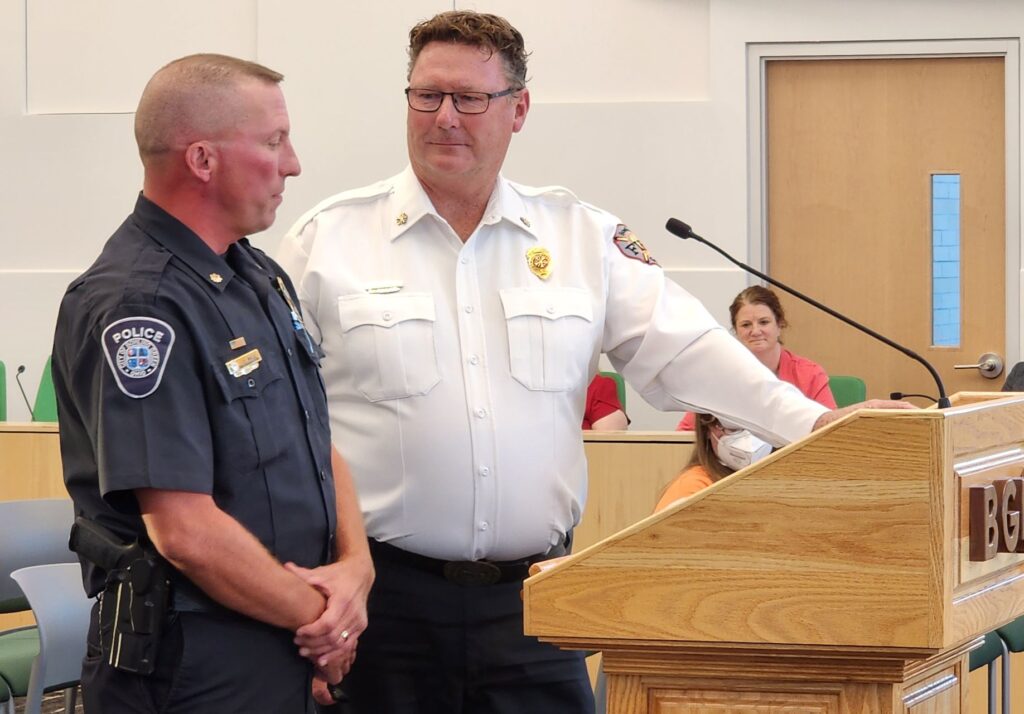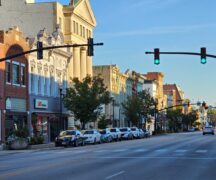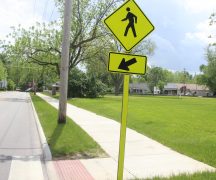By JAN McLAUGHLIN
BG Independent News
After years of putting fire and police building needs on the back burner, Bowling Green leaders have studied the deficiencies and are looking for a cure.
On Monday evening, Mayor Mike Aspacher reported that the Court Street fire station and the downtown police station have been assessed and possible solutions identified.
“We want to make sure we are doing all we can to support our first responders,” Aspacher said.
Leaders of the police and fire divisions are taking that information on the road, speaking with citizen and service groups in the city. On Monday evening, Fire Chief Bill Moorman and Police Major Justin White gave their presentation to Bowling Green City Council.
The quick summary is this – the East Side fire station is no longer a safe place for fire and EMS crews, and studies of other locations have shown that response times could be cut if the station is moved or if two stations are built.
The police station building is a maze of inefficient spaces built 130 years ago. City and police officials agree that the station should remain downtown – but it must be made more user friendly to the public and police.
The ultimate goal for both stations is to provide adequate facilities for the city’s first responders and minimize the time it takes to respond to emergencies.

Fire: There are two emerging issues in terms of fire service. First, the Court Street station condition is currently unsustainable, Moorman said.
- Based on a professional analysis, the station is not acceptable and will be prohibitively expensive to bring up to current standards.
- The station turns 40 years old this October. No major improvements have been made since it was constructed.
- A structural analysis in recent years revealed significant structural deficiencies. Additionally, the aging HVAC system, roof and plumbing need to be replaced.
- The building is not compliant with current health and safety and ADA regulations.
- The building, which was built on the site of an old quarry, has settled more than 6 inches from front to back.
- The living space for firefighters is above the engine room, presenting health risks due to diesel exhaust exposure.
- The fire station was built for an all-male workforce. The city recently retrofitted a closet to provide a bathroom for female firefighters.
- The vehicle bays are just barely able to hold today’s larger equipment. The slide for firefighters to slide down from their living quarters to the truck bay is not safe.
- The station lies only 150 feet from the CSX train tracks. There is the potential for a train derailment that could effectively take out up to 70% of personnel and equipment.
The other issue facing the community is response time. Time is crucial.
“We work in a profession where seconds make a difference,” Moorman said.
Consider this:
- Chances of survival of cardiac arrest fall from 40% when defibrillated at six minutes to 20% at eight minutes.
- At eight minutes, an unchecked fire can lead to a deadly flashover.
- Much of Bowling Green benefits from response times within the department’s response goals, which are driven by national standards – but significant portions do not.
- The fire division’s response goals are met for 74% of all fire incidents. So, about one-quarter of fire responses (26%) are longer than the standard.
- The response goals are met for 82% of all EMS incidents. About one-in-five (18%) EMS responses are longer than the standard.
- Because nearly 70% of the time the fire department is responding to simultaneous calls, response time impacts all residents, even those who live near a station.
- Any emergency response to any residence could come from any station.
The city asked the Ohio Fire Chiefs Association to study this challenge. The study presented two options, while also continuing to use the Pearl Street station:
Option 1: Replace the Court Street station with a single station further east.
- Addresses the Court Street station issues.
- Lower cost option.
- Uses existing staffing levels.
- Improves response times on the eastern side of the city.
- Leads to new areas of slow response time in the northern and southern parts of the city.
- When two or more incidents are occurring simultaneously, this option is not an improvement over the current approach.
Option 2: Replace the Court Street station with two stations, one on the east side of Bowling Green and one located further north.
- Significantly improves response times to almost all areas of the city’s populated areas, even when two or more calls come in simultaneously.
- Positions the fire division to meet current and future service delivery challenges as the city grows.
- This could be a more costly option and may require additional staffing.
Two economic considerations:
- By improving response times and travel distances from responding stations, the city’s fire rating from the Insurance Services Office (ISO) can be decreased, which lowers property insurance costs for home and business.
- The property where the Court Street station is located would be a prime location for economic development, bringing additional revenue to the city. It would work in concert with the city’s Gateway District.

Police
The exterior of the police station is a treasured reminder of Bowling Green’s heritage and architecture. It was built in 1893 and in the mid-1980s was subject to wholesale renovation from the north face back.
However, 40 years later, there is significant deterioration of the structure and functional changes are needed. The public has to go to second floor to access dispatch, and the building isn’t made for today’s technology needs.
The current police department facility presents multiple problems:
- The interior layout is not efficiently organized for a modern police operation.
- The building is difficult to access for the public looking to receive services.
- Facility is deteriorating with age (some elements of the north face are 100 years old) and needs to be refreshed.
- Roof, HVAC and mechanical systems are aging and in need of replacement.
Considerations for the community:
- The location of the current police station is effective and provides adequate service to all parts of the city.
- Furthermore, the architecture is valued in the community and has been considered worth preserving.
- Given this, a path forward could be to renovate the current building as was done in the mid-1980s, preserving the face of the building, the tower, etc.
- The interior of the building would be renovated to organize space that meets the needs of a modern police operation and is more adaptable to the future.
- An addition would be constructed on the south side of the building that would allow for increased public parking and an accessible ground floor dispatch center.
At the same time that building deficiencies need to be fixed, the fire and police divisions are working to meet growing demands for services.
White said the police division now responds to approximately 30,000 calls a year, and Moorman said the fire and EMS crews respond to about 3,600 calls annually – both sizable increases over the last decades.
City leaders will continue sharing this information with the community, collect input, then recommend a course of action to City Council. No cost estimates for any solutions have been made yet.
Comments may be emailed to bgcity@bgohio.org.





